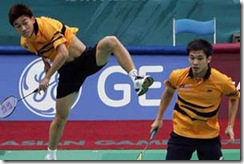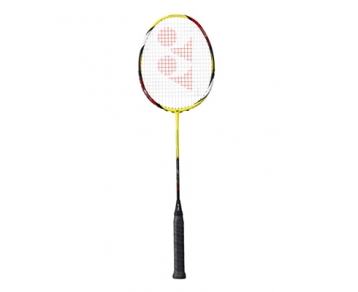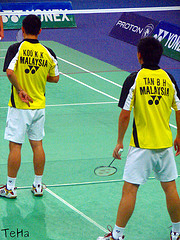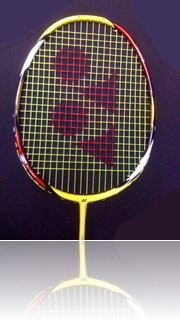
ClubsOnline.com.au
It’s been a good month for Malaysian Badminton Doubles player, Tan Boon Heong. First, he and Koo Kien Keat (who are currently the number 2 men’s doubles pair in the world) won a tight Men’s Doubles final against Mathias Boe and Carsten Mogensen in the Denmark Open.
Secondly, Yonex announced that using their new badminton racket, the ArcSaber Z-Slash, he hit the fastest badminton smash ever recorded – 421 km/h (262mph). This beats Naoki Kawamae’s record of 414 km/h (257mph) from earlier in the same test. Boon Heong’s responded to the announcement with a winning combination of pride and modesty,
“People started to notice my smashing ability when I was 17-years-old. And aware that it is one of my strong points, I spent extra hours working on it.”
“Having a strong smash alone is not enough. It is also important to have a good defence and to complement well with the partner. Kien Keat and I still have to work in these areas.”
The New Badminton Racket: ArcSaber Z-Slash
Kawamae’s record is being used as part of Yonex’s promotion of the ArcSaber Z-Slash – presumably because, as a Japanese company they wanted to advertise with a Japanese player for the Japanese open. Here’s the video of Kawamae hitting his 414km/h badminton smash – just listen to the sound of the impact!
This video is from Yonex’s ArcSaber Z-Slash website.
The Badminton Smash Record – still 332 km/h
For reasons I will outline below, the official badminton smash record is still 332km/h (206mph). This record was set by Chinese Badminton Doubles player Fu Haifeng (a left-hander like Boon Heong) in the 2005 Sudirman Cup. Boon Heong’s and Kawamae’s badminton smash records are significantly faster – is this because these players have much more powerful smashes, or because the ArcSaber Z-Slash is far superior to the Yonex Titanium 10 which Fu Haifeng used when he broke the record in 2005? I think not.
The badminton smash speeds with the ArcSaber Z-Slash are not comparable to Fu Haifeng’s record for three reasons:
- Measuring method: High speed video equipment was used in the Yonex speed trials rather than the microwave technology which is used to record shuttlecock speed in matches.
- Situation: The smash was not hit during a match. It is much easier to smash harder when the shuttlecock is being fed to you in a relaxed situation.
- Unofficial status of readings: The speed was recorded by Yonex rather than by badminton officials.
In fact, even in 2005, Fu Haifeng’s smash was not the fastest badminton smash to have been measured. At the 2001 Swiss Open, high speed video was used to measure badminton smash speeds in speed tests similar to that performed by Yonex at the Japan Open. The results (on the internet archive – can take a while to load) included a 364km/h smash from J. Laugesen of Denmark. But of course Fu Haifeng’s smash was considered to be the official record.
And of course, if Yonex are so confident they’d have compared the ArcSaber Z-Slash to other badminton rackets in the speed test and be publishing those results too.
You can draw your own conclusions about the effect that being in a speed test has on a player’s smash speed, but the technology used in each case is interesting too – so here’s some information about radar guns and high speed video compares for measuring shuttlecock speeds.
The Technology: Radar Guns and High Speed Video
Fu Haifeng’s record badminton smash was measured the same way speeds are measured during all sporting events: using a radar gun, which measures the change in frequency of microwaves bouncing off the moving object (in other words the gun measures the Doppler effect on the microwaves). The advantage of this method is that every shot in a rally can be logged, and the fastest can be displayed as soon as the the rally ends.
The Yonex speeds were measured using high speed video, which requires manual analysis of the speed, so cannot provide instant feedback. For this reason it is more suitable in test situations such as Yonex’ speed test. Here’s the high speed video in action measuring Boon Heong’s 421km/h smash:
This equipment, provided by NAC, typically records video at 300fps, allowing slow motion 6-12x slower than normal speed. This technology was used at the Olympics and is being used increasingly in sports for showing slow-motion replay – regular slow motion in sports coverage is around 3x slower than normal speed – approximately 75fps.
According to their site, their equipment will be used by SKY during their coverage of the All England next year. NAC’s site has a variety of interesting slow motion videos.
So is the big difference between Fu Haifeng’s record and Boon Heong’s badminton smash speed due to the measuring equipment used? Possibly.
Shuttlecocks are light and have high air-resistance, so they slow down significantly over a short distance. Slow-motion video captures can be used to measure the speed at any point in its flight, so Yonex’s measurement presumably measure the speed of the shuttlecock immediately after the initial impact, when it is at its fastest.
I am not convinced that the radar guns used in the Sudirman cup would have captured the speed immediately after impact. I have not been able to find much information on the internet about this – the most relevant information was from a baseball chat forum:
“The Jugs Speed Gun (Fast Gun) will pick up the speed of the fast ball after it has travelled 3.5 feet”
So it’s entirely possible that the radar gun speed measured the shuttlecocks a foot or so after impact, which would means that Fu Haifeng’s smash was actually significantly faster than the 332km/h which was recorded. However, this is pure speculation on my part as I not been able to discover what type of radar gun equipment is used now, let alone during the 2005 Sudirman Cup.
There’s also this information on a badminton forum:
“When the system gets a good lock onto the shuttlecock trajectory it is able to provide detailed measurements of the shuttlecock’s speed at more than 20 different points in its trajectory, illustrating the deceleration of the shuttlecock as it reaches the receiver. The top speeds measured at the Sudirman Cup are the speeds of the shuttlecock as it leaves the racket.”
Which does make it sound like the speed is measured immediately after impact. But I’m still not entirely convinced – it would be nice to have a more specific description than ‘immediately’.
Either way, it’s a shame the deceleration data is not available on the internet anywhere as it would be very interesting to know what speed the shuttlecocks are travelling at when they’re returned.
The ArcSaber Z-Slash – Ideal Badminton Doubles Racket?
So let’s forget about the 421km/h headline speed, and put aside Yonex’s bold claims that it makes players smashes 9.5% faster, and talk about the badminton racket itself.
I have not used an ArcSaber Z-Slash, but in this detailed review, Paul Stewart, a Yonex affiliated coach, has said,
“This is a pedigree racquet that requires coaxing into greatness. When you time your shot right, this beauty delivers power in abundance. And here lies the crux of the matter…’when.’ This racquet takes more getting used to than any I’ve used before.”
And here are some of the opinions from Badminton Central’s forum, in my opinion the best place on the internet to read the opinions of badminton enthusiasts:
”At first, the timing of the racquet was a problem. I often swung it too early.
Its small sweet spot also poses mishits during power shots such as smashing.
But the control and defence was superb and the small frame didn’t pose for these kind of shots.
After a few more days, it just improves. I stop myself from expecting strong smashes every time I smash the shuttlecock. My smashes then got stronger. Combined with the control and defence, it was just exciting playing with this racquet. Like others said, it is an unforgiving racquet when mis-hits.
All in all, this is one racquet that can surely deliver.”
https://www.badmintoncentral.com/forums/showpost.php?p=1279537&postcount=1104
”I now have about 12 hours on my ZS so here is my updated review.
Essentially I found out where I was going wrong with this badminton racket. I was being too passive, and it took a couple of games of singles to blow the cobwebs out and get in tune with the racket.
The Z isn’t a very forgiving racket, so if you try to be too clever or passive, it’ll bite you. But the reward is some serious power shots and speed around the court.”
https://www.badmintoncentral.com/forums/showthread.php?p=1272162#post1272162
“After accumulated 20 hours of play using the Arc Z i must say…….i am starting to LIKE IT!!!.
I dunno how to put it, this afternoon everything just click in. The smash, the overhead clears, the drives, even the net plays, net kills, drops. And the best “feel” is once everything clicked, ur overall game play actually speed up a lot. It was noticed even by my club captain.
Hope this is because finally i got used to the Arc Z and the reward it brings, Will test again this Tuesday to make sure it wasn’t a ONE OFF lucky day for me.
Till then, stay tune…..
TODAY MY ARC Z ROCKS BIG TIME!!!”
https://www.badmintoncentral.com/forums/showpost.php?p=1279208&postcount=1098
Prices
 It sounds like the ArcSaber Z-Slash is a badminton racket which rewards perseverance, and while it’s not going to give you a 400+km/h badminton smash (not unless you happen to be a world-class player already), if you have an aggressive style it could suit your play once you’re consistently hitting with the sweet spot.
It sounds like the ArcSaber Z-Slash is a badminton racket which rewards perseverance, and while it’s not going to give you a 400+km/h badminton smash (not unless you happen to be a world-class player already), if you have an aggressive style it could suit your play once you’re consistently hitting with the sweet spot.
I’ve had a look round at prices, here’s a list of the best prices I’ve found for different areas. By the way, if you find it cheaper elsewhere, please post in the comments and I’ll update the table for everyone’s benefit.
If you’re looking for other badminton products, then have a look at the badminton shop page where I’ve researched the best places to buy badminton kit, especially shuttlecocks and books.
So if you’ve found this article interesting and decide to buy an ArcSaber Z-Slash, please buy through my site and I’ll get a commission. Which will encourage me to write more articles – everyone’s a winner! 🙂



Hey please update it, because Matt Kolding just broke world record with 426 Kmph. Tan Boon Heong record just been broken in the match between Adcock/Kolding vs Ivonov/Sozonov in a losing cause of 11-6,11-6 in PBL.
Pingback: Bulu tangkis adalah olahraga raket yang | PinterPandai
Pingback: Phoenix Goes Pro with New Badminton Facility | Scottsdale Lifestyles Magazine
Yonex should deal with Fu Haifeng while he still fit on their next racket testing. Then we can compare with similar environment with TBH.
Agreed – but Fu Haifeng is sponsored by Kaisen (Li-ning) so unfortunately that’s never gonna happen!
If tan boon heong’s smash did clock 421km/h, how come he doesn’t even smash over 300km/h in tournaments?
TBH’s smash record smash was hit in a test situation – so with plenty of prep time, repeated consistent feeding and no pressure. That makes it significantly easier to hit a good smash, compared to in the middle of a tense match when the shuttle is hit to you by a top-class opponent who’s putting the shuttle in the most difficult place possible.
As impressive as TBH’s record is, I think Fu Haifeng’s is more impressive, as he has set a number of tournament records: see the Fu Haifeng wikipedia page for more details.
The speed of a radar gun will measure the speed at the very point of impact, as the way it works is it looks for a doppler frequency difference, which does not require any distance for the shuttle cock to travel. All it looks for is something moving fast, so it will also measure the speed of the racket, but will only look for the fastest object, so if the shuttle cock is moving faster than the racket, it will see the shuttle instead of the racket. Hope this helps.
That’s great information, thanks very much!
well, the smash record by Malaysia’s Tan Boon Heong is now recorded in the Guinness Book of World Records. 😉
http://www.badzine.net/news/badminton-in-guinness-book-of-world-records/2378/
Good spot – and congrats to Tan Boon Heong for such a great achievement.
But I still think Fu Haifeng deserves more kudos for the fastest smash in a match. 🙂
On another note – do any of the big events record shuttle speeds any more? When I was at the World Championships and All England earlier this year, they weren’t displaying this info, which is a real shame.
Pingback: Record Breaking Shuttlecock Juggling Video! « Badminton Doubles
The fastest smash ever produced is by Park Joo Bong in the mens’ double Yonex All England Final 1989. Park Joo Bong & Lee vs Rudy Gunawan & Edi Hartono. In one of the rallies when Rudy Gunawan served high to Park Joo Bong, Park Joo Bong Smashed it and he almost poked a hole on the floor. Hey this may be too long ago for you guys to remember. Park was using the Carbonex21.
I would love to have seen that. There are some YouTube videos of 1989 badminton matches, but not from the All England. And I think I picked up a badminton racket in 1989 so a bit before my time 😉
If there’s anything about it on the internet, please post a link. I just checked the relevant page on Wikipedia and there’s a space where the opposition should be….bet they’d love it if someone with your memories updated it!
Anyone else want to reminisce? There’s some threads like this one on badmintoncentral about the best ever badminton matches…none of which I’ve seen unfortunately 🙁
Hey Michael,
Excellent discussion of speed measurements, very informative –
exactly what I was looking for. One thing you did not discuss
though was the effect of “laser gun sightline” versus “direction
of the smash”. Obviously the laser can measure only the
component of the velocity vetor parallel to the sightline of the
laser. This will always give a velocity measurement less than
the actual velocity unless the smash is aimed directly at the
laser. On would need the angle between the two in order to
correct for this. Do you know how this is done?
Cheers, all the best,
Palle
Hi Michael
You’ve done an excellent job of this site.
I’m like you in that I’m not 100% convinced about the technology for measuring shuttle speeds.
You’ve summed up the Z Slash really well. I’m so excited about this racquet having played with it and yet I’ve still not mastered it.
But, I can’t wait to try it again.
Good luck with this site. I’ve bookmarked it and will frequently visit to keep myself up to date!
To your success
Paul
http://www.badminton-coach.co.uk